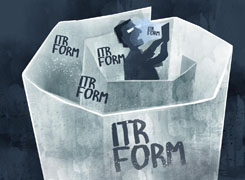Ramalingam Kalirajan |8319 Answers |Ask -Follow
Mutual Funds, Financial Planning Expert - Answered on Oct 24, 2024
He has an MBA in finance from the University of Madras and is a certified financial planner.
He is the director and chief financial planner at Holistic Investment, a Chennai-based firm that offers financial planning and wealth management advice.... more

Dear Sir, I am 29 yrs old, i need 30k monthly income apart from from my current salary, i have 2 lakh in MF, 2 lakh in stock, 5 lakh in ULIP , 9 lakh in post office MIS and 10 lakh surplus in liquid, (i also have 2 lakh liquid fund any kind of emergency). My question is how should I realign my investment to get 30k monthly income with increasing the investment capital at the same tym.
Assessing Current Investments
You have Rs 2 lakh in mutual funds and Rs 2 lakh in stocks.
Rs 5 lakh is tied up in ULIP, which combines insurance with investment.
Rs 9 lakh is invested in the Post Office Monthly Income Scheme (MIS).
You also have Rs 10 lakh surplus in liquid assets.
Rs 2 lakh is set aside as an emergency fund, which is well-placed.
Restructuring ULIP for Better Growth
ULIPs often have high charges that reduce returns.
Consider surrendering the ULIP and reinvesting in mutual funds.
Mutual funds offer better growth potential, especially with long-term investing.
Use a Certified Financial Planner (CFP) for selecting regular mutual funds.
Investing through a CFP helps you manage and track your investments effectively.
Maximising Growth with Equity and Balanced Funds
Allocate a portion of your Rs 10 lakh surplus to equity mutual funds.
Equity investments offer inflation-beating returns over time.
Consider balanced mutual funds for some stability and growth.
Balanced funds reduce risk by investing in both equity and debt.
Actively managed funds are better than index funds, as they can outperform markets.
Creating Monthly Income Through Systematic Withdrawal Plan (SWP)
Use your mutual fund investments to set up an SWP.
SWP offers flexibility in choosing the withdrawal amount and frequency.
Withdrawing Rs 30,000 monthly from equity or balanced funds spreads tax liability.
Any capital gains above Rs 1.25 lakh will attract 12.5% LTCG tax.
Plan withdrawals carefully to avoid higher taxes and protect your capital.
Redeploying Liquid Funds for Regular Income
Avoid keeping too much money idle in liquid funds.
Deploy a portion of the Rs 10 lakh in debt mutual funds or corporate bonds.
Debt mutual funds provide safety and better returns than savings accounts.
Use some amount to build a ladder of fixed deposits with different tenures.
This creates a steady cash flow without locking up all funds at once.
Rebalancing Post Office MIS Investment
The Post Office MIS has limitations on withdrawal flexibility.
Consider reducing some of your MIS investment to improve liquidity.
Reinvest in debt mutual funds to generate income with more flexibility.
Diversifying Stocks for Stable Returns
Review your stock portfolio to assess growth potential and risk.
If individual stocks are volatile, shift to mutual funds for better management.
Diversification spreads risk and stabilises returns over time.
Planning for Inflation and Future Income Needs
Rs 30,000 today will not hold the same value in the future.
Keep some investments in equity to protect against inflation.
Reinvest dividends and capital gains for wealth accumulation.
Monitoring and Adjusting Portfolio Regularly
Review your portfolio every 6 to 12 months with a CFP.
Rebalance investments based on market conditions and personal goals.
Regular monitoring ensures your strategy stays aligned with your objectives.
Final Insights
Focus on balancing income generation with long-term growth.
Redeploying ULIP into mutual funds improves returns.
SWP offers steady income while protecting your capital.
Diversify across equity, debt, and liquid assets for stability.
Keep reviewing your portfolio regularly with a CFP.
Thoughtful planning ensures sustainable income and wealth creation.
Best Regards,
K. Ramalingam, MBA, CFP,
Chief Financial Planner,
www.holisticinvestment.in
https://www.youtube.com/@HolisticInvestment
You may like to see similar questions and answers below
Sunil Lala | Answer |Ask -Follow
Financial Planner - Answered on Jan 19, 2024
Ramalingam Kalirajan |8319 Answers |Ask -Follow
Mutual Funds, Financial Planning Expert - Answered on Jul 22, 2024
Ramalingam Kalirajan |8319 Answers |Ask -Follow
Mutual Funds, Financial Planning Expert - Answered on Sep 27, 2024
Milind Vadjikar |1206 Answers |Ask -Follow
Insurance, Stocks, MF, PF Expert - Answered on Jan 03, 2025
Radheshyam Zanwar |1597 Answers |Ask -Follow
MHT-CET, IIT-JEE, NEET-UG Expert - Answered on May 05, 2025
Radheshyam Zanwar |1597 Answers |Ask -Follow
MHT-CET, IIT-JEE, NEET-UG Expert - Answered on May 05, 2025
Prof Suvasish Mukhopadhyay |612 Answers |Ask -Follow
Career Counsellor - Answered on May 05, 2025
Prof Suvasish Mukhopadhyay |612 Answers |Ask -Follow
Career Counsellor - Answered on May 05, 2025
Mihir Tanna |1052 Answers |Ask -Follow
Tax Expert - Answered on May 05, 2025
Samraat Jadhav |2269 Answers |Ask -Follow
Stock Market Expert - Answered on May 05, 2025
Samraat Jadhav |2269 Answers |Ask -Follow
Stock Market Expert - Answered on May 05, 2025
Samraat Jadhav |2269 Answers |Ask -Follow
Stock Market Expert - Answered on May 05, 2025
Ramalingam Kalirajan |8319 Answers |Ask -Follow
Mutual Funds, Financial Planning Expert - Answered on May 05, 2025
Prof Suvasish Mukhopadhyay |612 Answers |Ask -Follow
Career Counsellor - Answered on May 05, 2025




























